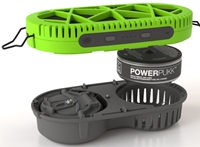Battery low? Give your mobile some water
30 Apr 2013
A power source for your mobile phone can now be as close as the nearest faucet, stream, or even a puddle, with the world's first water-activated charging device.
 |
| The MyFC PowerTrekk charger relies on fuel cell technology developed at KTH |
The MyFC PowerTrekk charger relies on fuel cell technology developed at KTH Royal Institute of Technology, Stockholm, based on its micro fuel cell technology, the MyFC PowerTrekk uses ordinary water to extend battery life for devices of up to 3 watts.
Anders Lundblad, KTH researcher and founder of MyFC, says that the device can be powered by fresh or seawater. The water need not be completely clean.
''Our invention has great potential to accelerate social development in emerging markets,'' Lundblad says. ''There are large areas that lack electricity, while mobile phones fulfil more and more vital functions, such as access to weather information or electronic payment.''
A USB connector attaches the compact PowerTrekk charger to the device. When plain water is poured onto a small recyclable metal disc inside the unit, hydrogen gas is released and combines with oxygen to convert chemical energy into electrical energy. The resulting charge is enough to power an iPhone to between 25 and 100 per cent of its battery capacity.
Lundblad has done research on micro fuel cells and small flat Proton Exchange Membrane (PEM) fuel cells for more than 15 years at the Department of Applied Electrochemistry at KTH. He says the business vision behind MyFC is to commercialise fuel cell technology and contribute to the development of environmental technology.
He says the charger is the first step toward building fuel cells in laptops.
''The launch of our charger is a strategic move to gain wide acceptance of fuel cells throughout society,'' he says. ''Our chargers may be considered expensive now; but in the longer term, as they reach a mass market, they would go down in price.''
 |
| MyFC founder, Anders Lundblad, researched fuel cells for 15 years at KTH |
Fuel cells can already be found in electric cars, trucks and buses, and backup electrical power supply systems for hospitals and cogeneration plants. The process by which fuel cells generate electricity is considered to be safe and environmentally-friendly, and the only by-product is water vapour. The fuel cell system is passive and has no fans or pumps.
Lundblad says that fuel cell chargers are faster and more reliable than solar chargers. The main target groups for MyFC PowerTrekk are those who travel or live in remote areas of the world, outdoor enthusiasts and aid workers, he says.
The charger is both a fuel cell and a portable battery, providing a direct power source as well as a storage buffer for the fuel.
MyFC plans to open an online shop for its MyFC PowerTrekk product. The company has already sold the technology to users in China, Japan, the US and much of Europe.